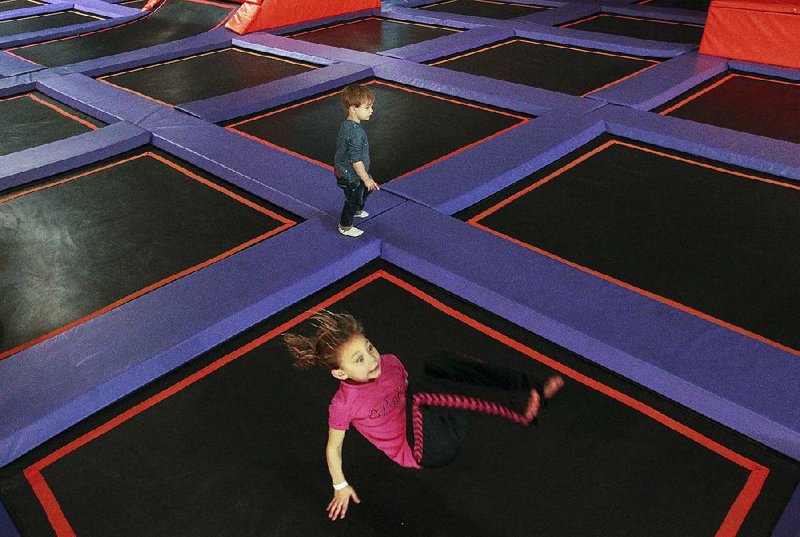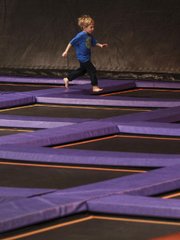"Go outside and play."
It is an often-repeated, generations-old instruction from parents to children.
RELATED ARTICLE
http://www.arkansas…">Indoor places to jump, skate, swim
But as technology races at lightning speed and people become more sedentary, that request is more often met with opposition. Especially if inclement weather is involved.
"When it's cold out, it's hard to find things for them to do," says Betty Brannon of Searcy, who was visiting Altitude Trampoline Park in Little Rock on a recent Friday. Her son Jake and three of his friends -- Jackson Benight, Maguire Rodgers and Wyatt Mote -- were there as a part of his 15th birthday celebration.
"We come here a couple of times of year," Brannon says, adding that the boys often play together but not always in person.
Brannon says her son isn't interested in sports and doesn't participate in any of them. He doesn't watch a lot of TV, but he's often looking at a computer or a phone screen.
"They do a lot of video playing," she says of her son and his friends. "They all have laptops and can all be in their own homes but still playing a game together. In teaching him to drive, I noticed that he doesn't know how to get around because when we are in the car, his head is always down. When I was a kid, I knew how to get around everywhere."
Jake isn't much of a bike rider, either, she says.
"He has a bike but he isn't on it very often," she says. "When I was a kid, my bike was like my car."
Dr. Samiya Razzaq is a pediatrician at Arkansas Children's Hospital, associate professor of pediatrics at the University of Arkansas for Medical Sciences, and medical director of the hospital's Arkansas Children's Center for Exercise and Nutrition Therapy Clinic. She says the current generation of children doesn't get as much
physical activity as previous ones did.
"Children today are living lives of luxury," she says. "They don't think about things like having to walk to the store and then having to carry all those bags of groceries back home.
"Today, our children are driven everywhere ... . Instead of having a phone on the wall that we had to get up to answer like I had, we now have cellphones right next to us. And instead of getting up to change the channel on the TV, we have remotes next to us."
Razzaq recalls her childhood in Tokyo in the 1970s.
"The schools I went to were two hours away and all the children went together, catching two trains and then walking for 30 minutes to get there," she says. "I was doing this with my siblings when I was as young as in the first grade."
"These days, parents don't feel as safe about letting their children venture out on their own."
Even if children play sports, most take in the same amount of calories or more than they're burning.
"Maybe a child will burn 100 to 200 calories during a game but afterward, they are given a sugar-filled sports drink that has 250 calories."
The combination of poor diets and lack of exercise means children today are becoming sicker earlier.
"If I have a child who comes into the clinic and he's 60 pounds overweight, I will explain to him that it's like he's carrying a 6-year-old around," Razzaq says, adding that the excess weight puts an added strain of all of the body's systems.
"We are seeing young people with problems we've never really seen in children before -- co-morbidity issues such as high blood pressure, high cholesterol and sleep apnea. And unless we work to change it, it will continue on for generations to come. We need to work to not only fix this problem but to prevent the problem from occurring in their children and grandchildren."
Razzaq says encouraging children to sit up straight instead of reclining will help with their core muscle mass, adding that young children shouldn't be encouraged to lift weights because they aren't finished growing. Instead, she recommends aerobic activity.
"They need to get their heart rate up," Razzaq says. "Parents need to be sure their children are burning up as much calories as they're taking in."
OLD-SCHOOL GAMING
Instead of buying gym memberships or expensive exercise equipment that might not be used, Razzaq says, parents should return to the basics and be creative in finding physical activities children enjoy. Then they will be more likely to incorporate exercise into their daily routines.
"Putting on music and dancing around and doing simple things like, when you go to the store, park in the farthest spot away and do a little extra walking," she says.
Razzaq suggests making up games that involve going up and down the home's stairs or buying a small personal-size trampoline.
"When watching TV, have the children do some type of physical exercise during the commercials. During a half-hour show that will easily add up to eight to 10 minutes of workout time."
For those playing video games, parents can have them set an alarm on their phone as a reminder to get 10 minutes of exercise after every 16 minutes of gaming time.
"You can go for a walk with them or play tag with them," she says.
There are easy ways to determine whether the amount and level of activity has been sufficient.
"If you can sing after you've worked out or done an activity, then you didn't get your heart rate up enough, but if you're out of breath and can't complete a sentence, you probably did."
Will being out in lower temperatures harm a child? Not at all, says Razzaq, adding that children should be dressed properly to be outside with coats, hats, scarves, gloves and thick-soled shoes.
"If it's really too cold to get out of the house, they need to try to get in at least an hour of exercise, even if it's 10- to 15-minute sessions three to six times a day," she says.
ALL THE RIGHT MOVES
Steven Laster, who specializes in youth fitness at Athletic Revolution Riverdale at Extra Innings in Little Rock, teaches children how to move better.
"People move in three different planes -- front and back, left to right, and in circles," he says.
Laster offers three types of classes based on developmental levels -- the very young (ages 6 to 9), 'tweens (10 to 13) and teens (14 to 18).
"In one class, we have some eighth- and ninth-graders we call the mathletes; they don't play any sport and don't want to," he says. "They may have played rec soccer or T-ball, but they're not really attracted to sports and are hesitant about being athletic. We work on teaching them how to squat, jump, catch and spin."
Laster, who has three daughters ages 10 to 20 and works with teenage female soccer and basketball players, says that now through February is a prime time for those who are athletic to work on improving their strength, balance and ability to change direction.
"These days kids want to sit on the couch and play video games instead of going out," he says. "We need to be more like our parents were and tell them, 'Go outside and play.'"
Family on 12/30/2015


